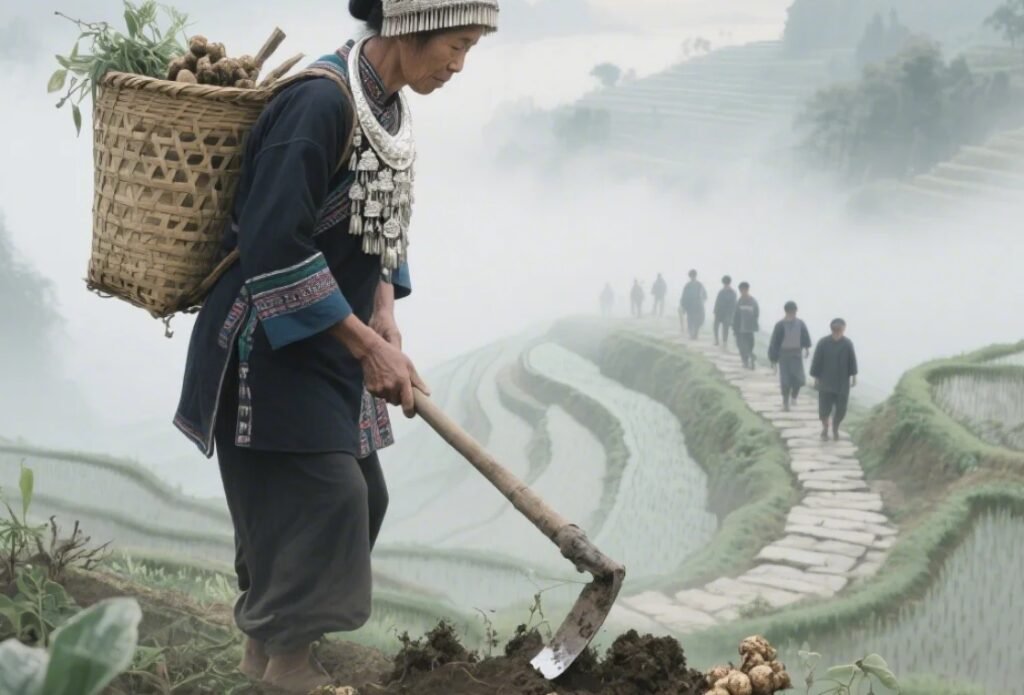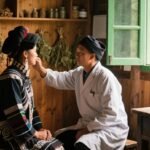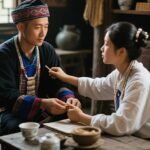Ouwajia’aluo (Urinary Strangury and Retention Syndrome)
[Overview]
In Miao medicine, all forms of urination difficulty regardless of cause are collectively known as Ouwajia’aluo, a condition similar to “Long Bi” (urinary obstruction) in Traditional Chinese Medicine (TCM).
In TCM, Long Bi is a disorder characterized by impaired transformation of qi in the kidneys and bladder, resulting in difficult urination, a significant reduction in total daily urine volume, and in some cases, complete obstruction. “Long” refers to difficult urination that is slow and dribbling, typically with a gradual onset and milder symptoms, while “Bi” indicates complete urinary blockage with an acute course. Although these are distinguished by severity, both refer to the same issue of urination difficulty, and are often discussed together clinically.
In Western medicine, conditions such as neurogenic urinary retention, bladder sphincter spasm, urinary calculi, urinary tract tumors, urinary tract trauma, urethral stricture, prostatic hyperplasia in elderly men, and spinal cord inflammation, as well as renal insufficiency causing oliguria or anuria, can be evaluated and treated with reference to this Miao disease.
[Huhoujipeng · Miao Medical Syndrome Classification]
Ouwajia’aluo is classified as a minor condition in Miao medicine, further divided into Hot-channel Long Bi and Cold-channel Long Bi types.
[Aijiangduo · Causes]
Miao medicine holds that this condition arises from complex and unclear causes, often related to bodily weakness and prolonged exposure to dampness and cold. Qi and blood are the foundations of life, deriving from the same source and mutually dependent. It is said: “Injury to qi inevitably harms the blood, and damage to the blood weakens the qi.” Blood and water are tangible substances: water gives rise to blood, and blood carries water. Hence, the Miao medical adage: “Water generates blood; blood carries water; water and blood are mutually blended. Without water, blood cannot form; without blood, water cannot nourish the body.” Qi, blood, and water are interdependent and mutually influential. When pathogenic damp-toxins invade internally, they injure qi and blood and damage the kidney framework (shenjia), impairing its ability to manage water and urination, thereby resulting in this disease.

[Gengduomeng · Pathogenesis]
When cold-damp toxins invade the body and persist without resolution, they damage the kidney framework, impairing its regulation of water and urine. Alternatively, internal invasion by pathogens may injure qi and blood, causing heat in the blood and qi stagnation, which blocks urination and leads to fluid retention—especially in the abdomen and lower limbs—despite the urge to urinate. In elderly individuals with weak constitutions, internal accumulation of cold-dampness can obstruct the urinary tract. Over time, dampness may transform into heat, damaging blood and fluid, leading to stone formation that blocks the urinary tract and prevents urination. Cold-channel type is the more common presentation. Hot-channel urination difficulty typically results from toxic heat damaging the urinary system.
[Key Diagnostic Points]
Diagnostic Criteria
Sudden onset or gradual worsening characterized by difficult urination, dribbling urine, or even complete blockage with no urine output, with a markedly reduced daily urine volume.
Possible abdominal distension, empty bladder on examination, and symptoms like edema, dizziness, chest tightness, and shortness of breath.
Often occurs in elderly males, post-abdominal surgery patients, or those with edema, strangury, or wasting-thirst conditions.
Relevant Examinations
First, physical examination and bladder ultrasound are used to determine urinary retention. If retention is present, urodynamic studies should be performed to identify mechanical obstruction.
For obstructive causes: Perform digital rectal exams, prostate ultrasound, urethral and bladder imaging, PSA testing, etc., to diagnose conditions such as prostatic hyperplasia, prostate cancer, urethral stones, or traumatic urethral strictures.
For non-obstructive retention: Consider spinal inflammation or neurogenic bladder; conduct neurological assessments accordingly.
In cases without retention: Consider renal failure and assess serum creatinine, blood urea nitrogen, CBC, urinalysis, liver and kidney function tests, calcium, phosphorus, ultrasound, DR, or CTX imaging. For acute renal failure, evaluate urine specific gravity, osmolality, sodium concentration, fractional sodium excretion, and intravenous pyelogram to differentiate prerenal, renal, or postrenal failure. Chronic renal failure requires further etiological investigation.
[Differential Diagnosis]
Dong’ouwa’ounu (Strangury Syndrome)
Both conditions feature scanty, painful urination and difficulty urinating. Dong’ouwa’ounu is characterized by frequent and urgent urination, dripping, urethral pain, lower abdominal tension, and radiating pain to the waist and abdomen. Pain occurs during urination, but total daily urine output remains normal.
Ouwajia’aluo, on the other hand, involves difficult urination with a significantly reduced daily urine volume, dribbling, and even complete blockage, without pain during urination. The total daily urine volume is far below normal, often absent.
Ouwajia’aluo can be aggravated by damp-heat and may co-occur with Dong’ouwa’ounu, while persistent Dong’ouwa’ounu may develop into Ouwajia’aluo.
[Syndrome Differentiation and Treatment]
Hot-channel Long Bi
Symptoms (Menglidu): Difficult urination, abdominal distension, scanty and hot urine, pain, thirst without desire to drink, constipation, dribbling urination, restlessness, shortness of breath.
Pathological Channel (Xingleng): Hot channel, hot disease.
Treatment Principle (Jiahemeng): Clear heat and detoxify (Xugakai’datajia), promote urination (Dawaju).
Herbal Formula and Explanation (Ouduoxijia, Gang’ou):
Shiweicao (Lygodium japonicum)– 18g
Cheqian cao (Plantago asiatica) – 20g
Shidagonglao (Mahonia fortunei) – 15g
Fengwei cao (Pteris multifida) – 15g
Decoction.
These herbs are cold in nature and enter the hot channel to promote urination, clear heat, cool the blood, and detoxify.
Cold-channel Long Bi
Symptoms (Menglidu): Dribbling urination, inability to void with force, pale complexion, soreness in the lower back and knees, aversion to cold, irritability, poor appetite, no thirst.
Pathological Channel (Xingleng): Cold channel, cold disease.
Treatment Principle (Jiahemeng): Warm the center and dispel cold (Hetongzhangshe), tonify the kidneys (Budiu), promote urination (Dawaju).
Herbal Formula and Explanation (Ouduoxijia, Gang’ou):
Yinyanghuo (Epimedium brevicornum) – 20g
Xuduan (Dipsacus asper) – 20g
Huangjing (Polygonatum sibiricum)– 15g
Niuxi (Achyranthes bidentata)– 15g
Decoction.
These herbs are mostly warm and enter the cold channel to tonify the kidneys and invigorate yang. Niuxi (Achyranthes bidentata), though cold, promotes urination, resolves dampness, activates blood, and detoxifies.
[Prevention and Care]
Strengthen the body and immune system through regular exercise and lifestyle habits. Avoid prolonged sitting or overexertion.
Maintain a calm and cheerful mood; avoid excessive worry or anger.
Prevent external pathogenic invasion and internal damp-heat accumulation by avoiding fatty, spicy food, excessive alcohol, holding in urine, and overindulgence.
Actively treat conditions like strangury, edema, urinary tumors, and stones.
For patients requiring catheterization due to urinary retention, strictly adhere to hygiene and operational standards. Catheterized patients should maintain perineal cleanliness, drink ample fluids (aim for over 2500 mL daily), and open the catheter every 4 hours. Remove the catheter promptly once voluntary urination resumes.
[Remarks]
Miao medicine holds that qi, blood, and water are the foundational substances of the human body. Water, as the source of life, is an essential component. The intake, transformation, ascension, and excretion of the body’s “four waters”—original water, essence water, nourishing water, and waste water—are essential to metabolism and physiological function. When the kidney framework is impaired, water-related disorders arise, leading to Dong’ouwa’ounu and Ouwajia’aluo due to urinary obstruction.


Leave a Reply